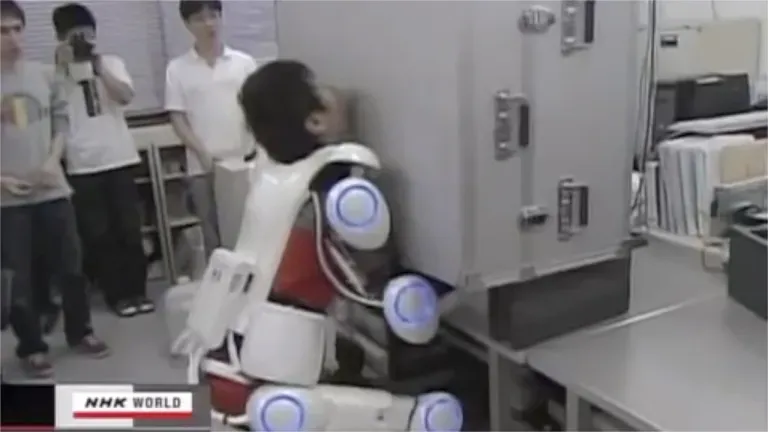Lower-Extremity Rehabilitation Robots
Previously, we learned about rehabilitation and the importance of robot-aided rehabilitation. We have also seen some of the upper-limb rehabilitation robots and how they operate. In this lesson, we will become familiarized with lower-limb rehabilitation robots that are helpful for patients with lower-extremity disorders.
Lower-extremity exoskeleton robots can be designed to help the movement of a specific joint, or they are designed for gait rehabilitation. They can also serve as assistive devices to perform activities of daily living (ADL).
Joint-specific Rehabilitation/Assistive Exoskeleton Robots
Joint-specific rehabilitation/assistive exoskeleton robots are used for body joints rehabilitation and can be made to rehabilitate or assist the hip, knee, or ankle joints and support those joints during walking.
Samsung made three versions of the GEMS (Gait Enhancing and Motivating System) exoskeleton, namely GEMS-H, GEMS-K and GEMS-A that each target the hip, knee, and ankle joints, respectively. The exoskeletons can help with walking and reduce the metabolic cost of walking.

GEMS can also be combined with Augmented Reality (AR) technology and can help users with, for example a personalized fitness routine.

Ascend is a knee brace from Roam Robotics that can support the knee joint and reduce the pain associated with it helping people with osteoarthritis to regain their mobility.

The ankle joint plays an important role in human activities such as standing, walking, and sitting. For instance, Standford researchers have developed an exoskeleton to support ankle joint and they showed that this motorized device can greatly reduce the energy cost of running.

Gait Rehabilitation Exoskeleton Robots
Gait rehabilitation exoskeleton robots assist patients in completing walking with a normal gait and provide power. These exoskeletons are suitable for patients with abnormal gait trajectory or joint trajectory.
Hybrid Assistive Limb (HAL) is a hybrid gait machine that uses EEG signals to detect the intention of the user, and the robot control can further improve the human-machine interaction function for this exoskeleton.

LOKOMAT is a commercial lower-extremity exoskeleton robot that is widely used in clinical practice. It stimulates physiological gate trajectory and can drive the patient’s unilateral or bilateral limbs. The speed of the treadmill can be controlled to match the patient’s gait.

EksoNR is a lower-limb exoskeleton that helps patients to stand and walk. This exoskeleton is the first exoskeleton that is cleared by the US food and drug administration (FDA). It can treat patients after stroke, brain injuries, and spinal cord injuries (SCIs) to regain their mobility and normal gait.

In conclusion, lower limb exoskeleton robots provide assistance and rehabilitation to lower-extremity joints or they can be used in gait training. These robots provide therapy, protection, support, and assistance to reduce the burden on the limbs, and assist patients to complete activities of daily living (ADL). These exoskeletons are suitable for stroke patients, brain trauma patients, patients with moving disorders caused by spinal cord injury SCI, elderly people with muscle weakness and insufficient joint strength. They provide power to the lower limb to climb stairs, squat, sit-to-stand, and walk. With a better design, improved control methods, and human-machine interaction, the lower-extremity exoskeletons can function better and better every day in assisting patients.
References:
- Lee, H.J., Lee, S., Chang, W.H., Seo, K., Shim, Y., Choi, B.O., Ryu, G.H. and Kim, Y.H., 2017. A wearable hip assist robot can improve gait function and cardiopulmonary metabolic efficiency in elderly adults. IEEE transactions on neural systems and rehabilitation engineering, 25(9), pp.1549-1557.
- Bai, O., Kelly, G., Fei, D.Y., Murphy, D., Fox, J., Burkhardt, B., Lovegreen, W. and Soars, J., 2015, November. A wireless, smart EEG system for volitional control of lower-limb prosthesis. In TENCON 2015-2015 IEEE Region 10 Conference (pp. 1-6). IEEE.
- Viteckova, S., Kutilek, P. and Jirina, M., 2013. Wearable lower limb robotics: A review. Biocybernetics and biomedical engineering, 33(2), pp.96-105.
- Díaz, I., Gil, J.J. and Sánchez, E., 2011. Lower-limb robotic rehabilitation: literature review and challenges. Journal of Robotics, 2011.
